Exploring the Therapeutic Potential of Water
Water-based therapy, often referred to as hydrotherapy or aquatic therapy, harnesses the unique physical and physiological properties of water to promote healing, alleviate pain, and restore mobility. Rooted in centuries of practice dating back to ancient civilizations, contemporary water-based therapy combines both passive and active modalities designed to serve diverse populations, from athletes recovering from injuries to older adults managing chronic conditions. This article delves into the myriad benefits and scientific foundations of water-based therapy, examining how its principles optimize rehabilitation and improve quality of life across multiple patient groups.
Historical Origins and Evolution of Water-Based Therapy
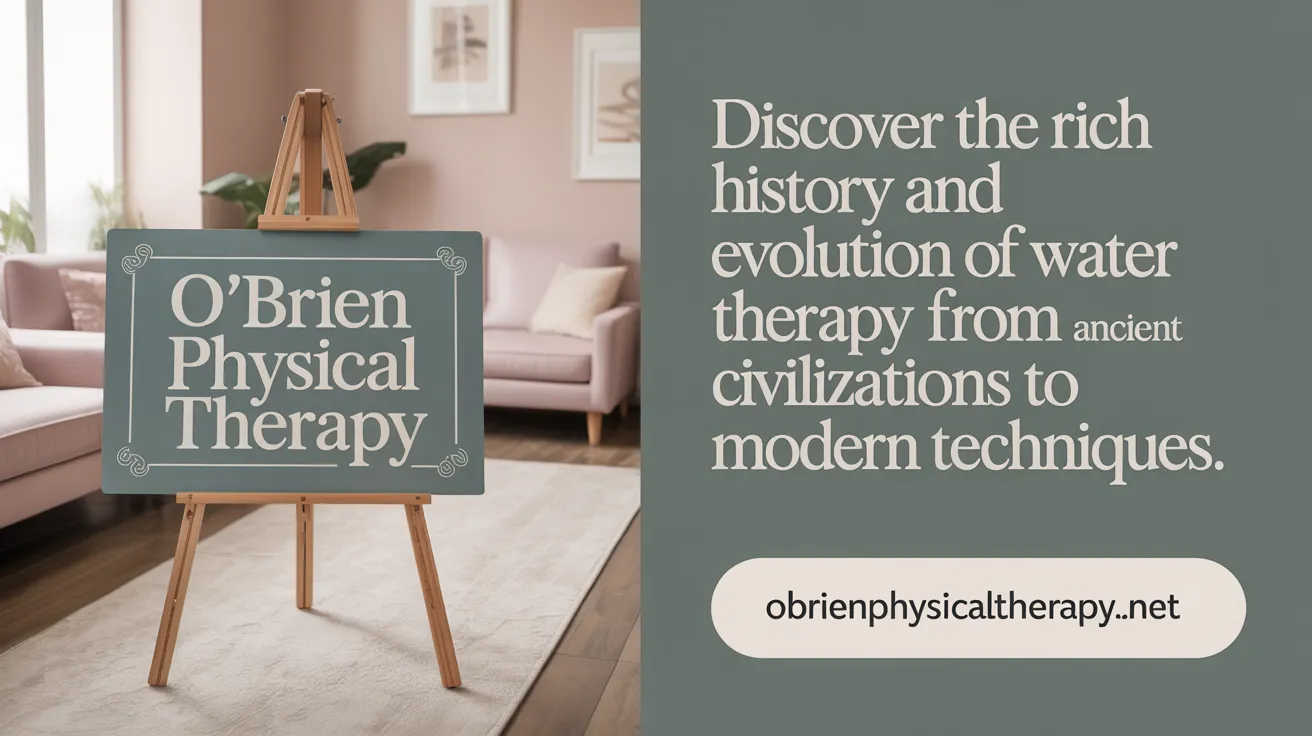
Historical use of water in therapy
Water has served therapeutic purposes since ancient civilizations, prominently the Egyptians, Greeks, and Romans. These cultures recognized warm baths and water immersion as beneficial for healing and rehabilitation, laying the foundation for today’s water-based therapies and the history of hydrotherapy.
Distinction between hydrotherapy and water therapy
Hydrotherapy primarily involves passive treatments using water, such as baths, compresses, or temperature modulation to relieve symptoms like pain and stiffness. In contrast, water therapy emphasizes active participation—exercises and movements utilizing water’s physical properties like buoyancy, resistance, and hydrostatic pressure to rehabilitate and condition the body.
Evolution of aquatic therapy methods
Over time, water therapy evolved beyond simple immersion. Structured forms emerged, including the Halliwick Method, Bad Ragaz Ring Method, and the Burdenko Method which integrates both water and land exercises. These approaches harness water's support and resistance to improve balance, flexibility, strength, and coordination, translating gains safely onto land. Modern aquatic therapy combines traditional principles with evidence-based practices to address diverse health conditions effectively.
Physical Properties of Water that Facilitate Healing
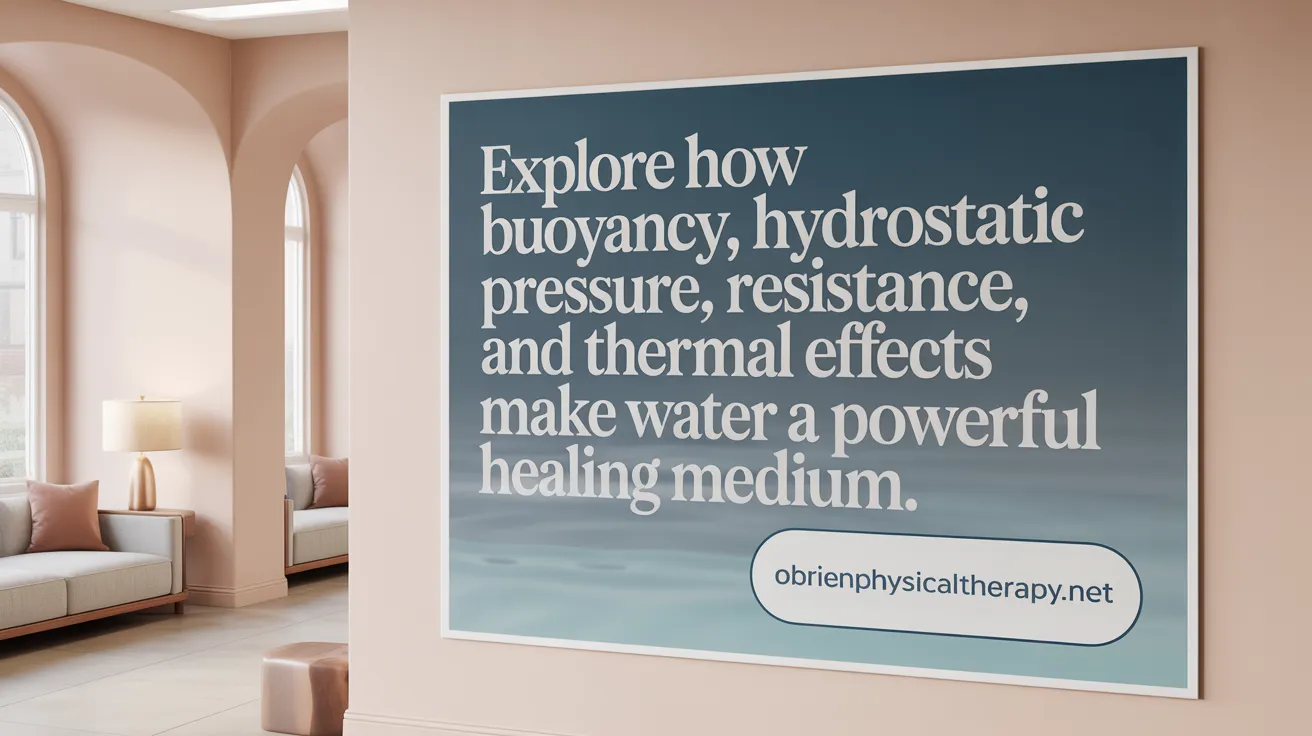
Buoyancy and its role in reducing joint load
Buoyancy is a unique property of water that supports body weight during immersion. This significantly reduces the load on joints and bones, making movements easier and less painful. For example, immersion to neck depth can decrease body weight load by up to 90%, allowing patients with joint pain or mobility limitations to exercise with less strain. This reduction in joint pressure aids tissue repair and facilitates pain-free movement, which is especially beneficial during rehabilitation (benefits of combining water and land-based therapy, Buoyancy reduces joint impact, Aquatic physical therapy benefits).
Hydrostatic pressure benefits
Hydrostatic pressure is the force exerted by water on the body when submerged. This pressure promotes increased circulation by gently compressing tissues, which can reduce swelling and inflammation. Enhanced blood flow improves microcirculation, supporting tissue healing and recovery. Additionally, hydrostatic pressure helps stabilize joints and muscles, contributing to better proprioception and balance during aquatic therapy (Hydrostatic pressure effects in therapy, Hydrostatic pressure benefits in therapy, Hydrotherapy benefits and uses).
Water resistance and muscle strengthening
Water provides natural resistance that is greater than air, allowing for controlled muscle strengthening with minimal injury risk. This resistance helps improve muscle tone and endurance as patients perform exercises against water’s drag forces. The resistance is uniform and multi-directional, enabling comprehensive strengthening and coordination across various muscle groups. Resistance in water supports gradual progression in rehabilitation without exacerbating pain (Water resistance for muscle strengthening, Benefits of hydrotherapy, Aquatic physical therapy benefits.
Thermal properties and muscle relaxation
Water’s thermal qualities also play a pivotal role in therapy. Warm water immersion relaxes muscles, reduces tension, and increases blood flow to soft tissues. This warmth aids pain relief and enhances joint flexibility by loosening tight muscles and connective tissues. The soothing effect of warm water promotes relaxation and can reduce muscle spasms, facilitating easier movement and more effective exercise sessions in the aquatic environment (Warm water therapy effects, Hydrotherapy benefits and pain relief, Hydrotherapy warm water immersion benefits).
Physiological Effects of Water Immersion
Cardiovascular responses to water temperatures
Water immersion can significantly affect cardiovascular function depending on the water temperature. Immersion in warm water around 32°C typically lowers heart rate and both systolic and diastolic blood pressure. It also decreases plasma levels of renin, cortisol, and aldosterone, which contribute to reduced stress on the cardiovascular system. In contrast, colder waters (about 14°C) increase metabolic rate markedly and stimulate the sympathetic nervous system, causing rises in heart rate, blood pressure, and catecholamine concentrations. These changes enhance blood flow and cardiac output, which can benefit patients with heart failure or aid recovery after cardiac events (Scientific evidence of hydrotherapy effects.
Immune system activation
Hydrotherapy stimulates immune function through multiple mechanisms. Cold water immersion has been shown to elevate leukocyte counts, including natural killer cells and interleukins, strengthening the body's immune response. Regular exposure to such stimuli may improve defense against infections and may have potential applications in immunotherapy. Hydrotherapy also modulates cytokine levels, promoting an overall immune-regulating effect (Scientific Evidence-Based Effects of Hydrotherapy.
Respiratory improvements
Immersing the body in water, especially at thermoneutral temperatures like 25°C, increases oxygen consumption and respiratory minute volume, improving lung function. Hydrotherapy has been used successfully to aid patients with respiratory conditions such as chronic obstructive pulmonary disease (COPD), enhancing bronchial patency and reducing infection frequency. Additionally, local cold water applications may improve respiratory symptoms by stimulating the nervous system and clearing airways (Hydrotherapy effects on respiratory system.
Hormonal changes during hydrotherapy
Water immersion influences various hormonal systems involved in stress and pain regulation. Warm water bathing raises levels of norepinephrine, adrenocorticotropic hormone (ACTH), beta-endorphins, and cortisol. These hormonal shifts contribute to relaxation, improved mood, and analgesia. The hormonal responses help modulate the body's reaction to stress, reduce anxiety, and promote recovery during therapy sessions (Hydrotherapy and hormone regulation.
Together, these physiological effects demonstrate hydrotherapy's comprehensive impact on body systems, reinforcing its therapeutic value beyond simple symptom relief (Benefits of hydrotherapy.
Water-Based Therapy for Pain and Symptom Relief
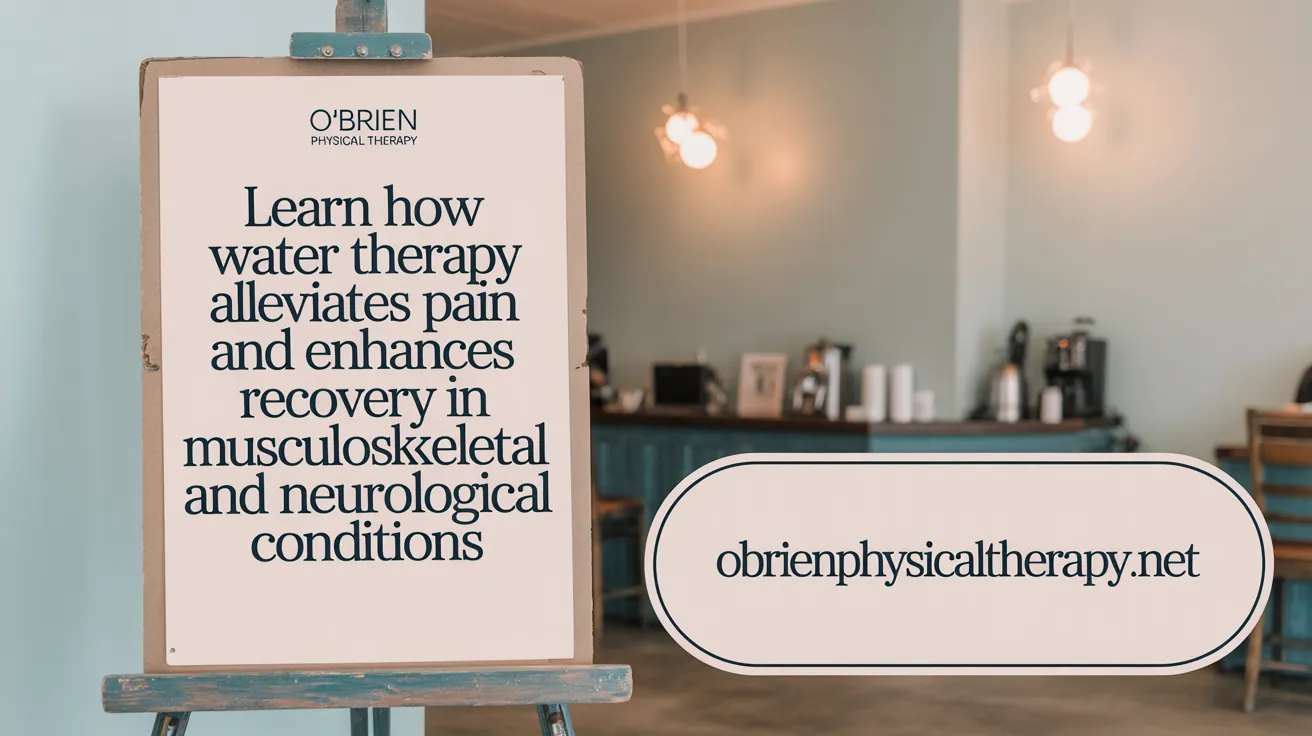
How Does Water Therapy Help Reduce Pain?
Water-based therapy leverages several physical properties of water to ease pain. The buoyancy of water supports body weight, reducing joint load by up to 90% at neck depth, which lessens stress on painful joints and soft tissues. Hydrostatic pressure from water decreases swelling and enhances circulation, promoting tissue healing and reducing discomfort. Additionally, warm water relaxes muscles and increases blood flow, further alleviating muscle spasms and stiffness.
How Does Water Therapy Provide Relief in Musculoskeletal Disorders?
Musculoskeletal conditions such as osteoarthritis, rheumatoid arthritis, and fibromyalgia benefit significantly from aquatic therapy. By lowering the impact on joints, water therapy allows patients to engage in low-resistance exercise that improves muscle strength and joint flexibility without exacerbating pain. Warm water immersion soothes stiff joints and increases range of motion, while aquatic exercise promotes recovery by reducing inflammation and enhancing microcirculation.
In What Ways Can Water Therapy Help Manage Symptoms in Neurological Diseases?
Individuals with neurological disorders like multiple sclerosis, Parkinson’s disease, and spinal cord injuries find water therapy particularly helpful. The supportive environment facilitates safe movement and balance training, reducing fall risk. Water’s sensory feedback can improve coordination, while exercises performed in water promote neural plasticity and muscle conditioning. These effects collectively contribute to improved mobility and decreased symptom severity.
What Are the Benefits of Water-Based Therapy for Chronic Conditions Like Fibromyalgia and Arthritis?
For chronic conditions characterized by ongoing pain and fatigue, water therapy provides gentle and effective symptom management. Patients often experience reductions in pain intensity, improved sleep quality, and enhanced overall well-being. The combination of warmth, buoyancy, and resistance allows for therapeutic exercise that lessens pain while enhancing strength and endurance, improving quality of life for those with fibromyalgia and chronic arthritis.
Applications in Neurological Rehabilitation
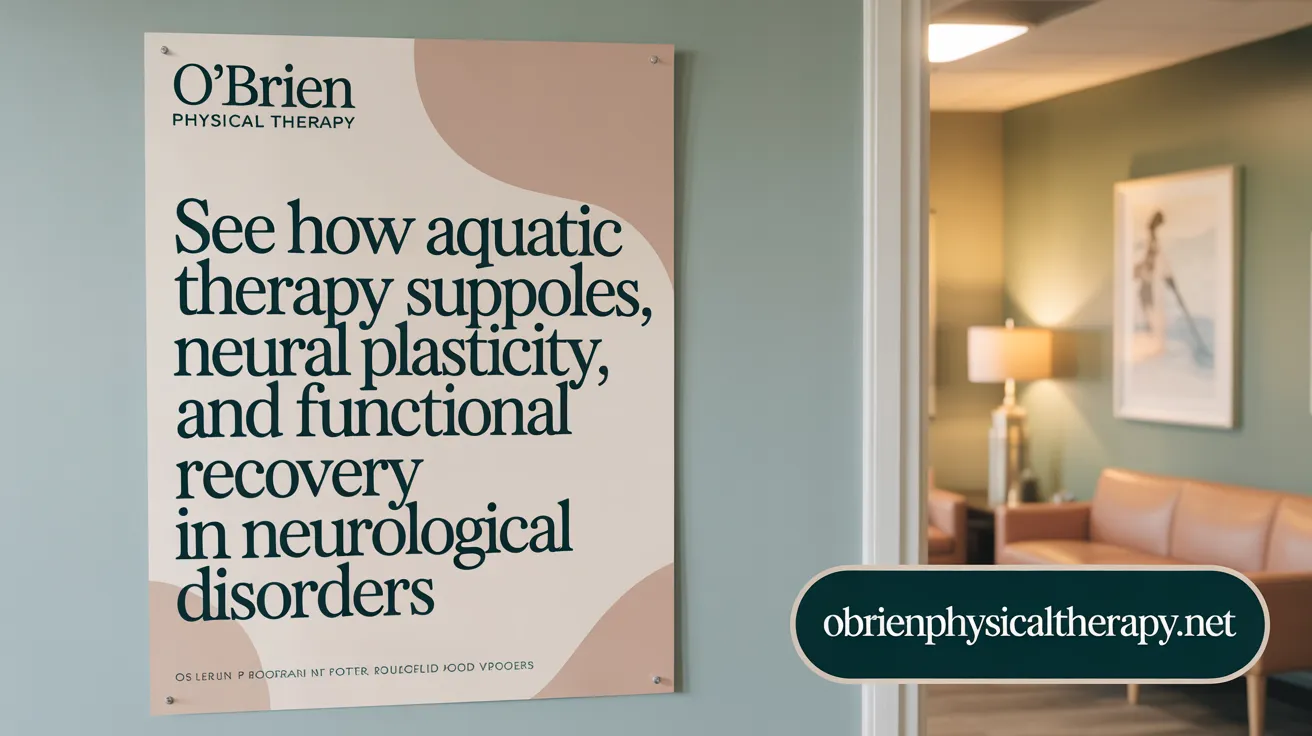
How does aquatic therapy improve balance and coordination?
Aquatic therapy supports balance and coordination improvements by harnessing water’s unique properties such as buoyancy in water therapy and water resistance for muscle strengthening. The buoyant environment slows down movements, allowing patients to practice postural control and stabilize themselves with confidence and reduced risk of falling. Hydrostatic pressure and sensory feedback from water enhance proprioception, which aids the central nervous system in refining balance responses.
In what ways does water therapy enhance neural plasticity and learning?
Exercise in water has been shown to promote neural plasticity by stimulating multiple sensory inputs and encouraging repetitive, controlled movements that help rewire brain circuits. The supportive environment allows patients to safely perform complex tasks that reinforce motor learning and cognitive function. Studies indicate aquatic therapy may improve overall brain health, including cognition and adaptability during recovery, as noted in research on water exercise and neural plasticity and aquatic therapy for neurological conditions.
What benefits does aquatic therapy offer for spinal cord injury and Parkinson's disease patients?
For individuals with spinal cord injuries, aquatic therapy reduces joint load and minimizes pain, enabling earlier and more effective functional training. The water’s resistance supports muscle strengthening while limiting injury risk. Parkinson's disease patients experience enhanced postural stability and gait improvements in water due to decreased fear of falling and improved muscle relaxation. These benefits contribute to better mobility and quality of life. Relevant insights can be found under water therapy for neurological injuries and older adults and Hydrotherapy in Parkinson’s Disease.
Are there case studies supporting neurological recovery through aquatic therapy?
Yes, multiple case studies of combined water and land therapy demonstrate successful neurological rehabilitation outcomes using combined water and land therapies. For example, patients with spinal cord injuries showed improved muscle strength and functional independence. Those with Parkinson's disease experienced increased balance and gait speed. The therapeutic effects have been documented in clinical practice and research, underpinning aquatic therapy’s role in neurological recovery programs.
Role of Hydrotherapy in Musculoskeletal Recovery
How Does Hydrotherapy Help Treat Osteoarthritis and Rheumatoid Arthritis?
Hydrotherapy is highly beneficial for managing symptoms of osteoarthritis and rheumatoid arthritis. By using warm water immersion and aquatic exercises, hydrotherapy reduces joint pain and stiffness through buoyancy and warmth. These properties lower joint pressure, enhance circulation, and promote muscle relaxation, which helps alleviate discomfort. Patients experience improved joint function and mobility, supported by multiple research findings showing pain reduction and enhanced quality of life for arthritis sufferers.
What Role Does Hydrotherapy Play in Post-Surgical Rehabilitation, Including Joint Arthroplasty?
After surgeries like hip or knee arthroplasty, hydrotherapy facilitates faster and safer rehabilitation. Water reduces body weight bearing by up to 90% at neck depth, limiting stress on healing joints. This buoyant environment permits early weight bearing and functional movement without aggravating tissues. Combined water and land therapy has shown superior outcomes in increasing range of motion and functional recovery compared to land therapy alone.
How Does Hydrotherapy Reduce Joint Stiffness and Swelling?
Hydrostatic pressure exerted by water during immersion helps reduce swelling by enhancing blood and lymph circulation, thus decreasing edema around joints. Warm water supports muscle relaxation and reduces joint stiffness by loosening tight connective tissues. Exercising in this medium helps restore joint range of motion and decreases discomfort, allowing patients to perform controlled movements with less pain.
In What Ways Does Hydrotherapy Contribute to Muscle Strengthening and Flexibility Improvements?
Water resistance provides a smooth but challenging medium for muscle strengthening without the harsh impacts of land exercises. It improves muscle tone and endurance safely and effectively. Warmth and buoyancy facilitate flexibility by reducing muscle tension and encouraging natural alignment during movement. Aquatic therapy also supports balance and coordination, which are essential for return to functional activities on land. For more on these benefits, see aquatic physical therapy benefits and the Burdenko Method combining water and land exercises.
Pregnancy and Labor Support through Hydrotherapy
How does hydrotherapy help regulate blood pressure during pregnancy?
Hydrotherapy has been found to reduce blood pressure in pregnant women, which can lower the risk of complications such as preeclampsia. Warm water immersion promotes relaxation and improved circulation, contributing to safer pregnancies by easing the cardiovascular load. This gentle method helps expectant mothers maintain healthier blood pressure levels as part of prenatal care.
Can hydrotherapy reduce pain and anxiety during labor?
Yes. Water therapy during labor, such as warm water immersion or laboring in a pool, can significantly increase comfort by relaxing muscles and reducing pain. It also lowers anxiety levels by providing a soothing environment. Many women report less need for analgesics during water-assisted labor and experience shorter labor durations. This method promotes natural pain management and enhances emotional well-being.
What safety considerations should be observed when using hydrotherapy in pregnancy?
While hydrotherapy offers benefits, it is essential to consult healthcare providers before starting to ensure suitability for individual conditions. Facilities should maintain water cleanliness and temperature control to prevent infections or burns. Overheating and prolonged exposure should be avoided to prevent maternal or fetal stress. Using licensed, certified providers and supervised settings minimizes risks like slips or falls, ensuring a safe experience for both mother and baby.
Combining Water and Land-Based Therapy for Optimal Recovery
Synergistic Effects of Dual-Modality Therapy
Combining aquatic and land-based therapy harnesses unique properties of both environments to enhance rehabilitation and recovery. Water's buoyancy reduces joint stress and allows pain-free movement, while its resistance aids muscle strengthening. Land therapy focuses on functional, weight-bearing activities and real-world movement patterns. Together, these therapies offer complementary benefits that accelerate healing and improve physical outcomes.
The Burdenko Method and Its Focus Areas
The Burdenko Method is a structured program integrating water and land exercises designed to improve six physical qualities: balance, coordination, flexibility, endurance, speed, and strength. By practicing dynamic, multidirectional movements in both environments, patients can better regain natural biomechanics and postural control, facilitating the transfer of skills from water to land.
Clinical Improvements in Range of Motion and Function
Research shows that combining water and land therapy yields faster and greater gains in range of motion, pain reduction, and overall function following orthopedic surgeries like rotator cuff repair or hip and knee arthroplasty. Patients often experience improved mobility and enhanced quality of life compared to using land or water therapy alone.
Evidence Backing Combined Therapy Over Single Modality
Multiple studies indicate that dual-modality therapy surpasses the outcomes of single-modality approaches. Specifically, combined aquatic and land therapy leads to superior improvements in strength, balance, and functional recovery in populations with neurological injuries, chronic musculoskeletal conditions, and older adults. The supportive aquatic environment reduces injury risk during early rehabilitation, reinforcing adherence and safety.
This integrative approach capitalizes on water's supportive properties alongside the practical challenges of land-based movements, offering a comprehensive path toward optimal recovery and long-term functional gains.
Water-Based Therapy for Older Adults and Chronic Disease
How Does Water-Based Therapy Improve Strength, Balance, and Flexibility in Older Adults?
Water-based therapy utilizes the buoyancy in water therapy and resistance properties of water to create a low-impact environment conducive to strengthening muscles and enhancing joint mobility. This is particularly beneficial for older adults, as water reduces the burden on joints by offloading body weight by up to 90% at neck depth, allowing more comfortable and pain-free movement in water.
Exercises performed in water can improve balance and coordination by providing a stable yet challenging setting that slows movements and increases sensory feedback. These effects contribute to enhanced postural control and a decreased risk of falls. Warm water helps relax muscles and decrease stiffness, further promoting flexibility and range of motion through warm water pain relief.
How Does Water Therapy Help Manage Chronic Musculoskeletal Conditions?
Aquatic therapy offers effective management of chronic conditions such as osteoarthritis, fibromyalgia, and low back pain by alleviating joint pressure and reducing pain. The combination of buoyancy, hydrostatic pressure effects, and water resistance reduces inflammation and swelling while supporting gentle resistance training to maintain or improve muscle tone.
Studies show water therapy leads to improvements in physical function, decreases pain levels, and enhances quality of life for individuals with chronic musculoskeletal issues. It also supports tissue repair by decreasing the effects of gravity on joints and spine, facilitating rehabilitation without exacerbating symptoms, as documented in water-based exercise for musculoskeletal disorders.
What Are the Aerobic and Cardiopulmonary Health Benefits of Water-Based Exercises?
Water-based aerobic exercises provide cardiovascular benefits by enabling low-impact, sustained movement that increases heart rate and respiratory function safely for older adults and those with limited mobility. Progressions in these exercises improve endurance and overall cardiorespiratory health through hydrotherapy benefits on cardiovascular health.
Warm aquatic environments enhance blood circulation and oxygen delivery, which helps maintain healthy blood pressure and supports lung function. This is especially important for individuals with cardiopulmonary challenges, promoting improved exercise tolerance and general well-being described in aquatic therapy benefits.
Integrating water therapy with land-based rehabilitation often results in superior clinical outcomes, such as better functional mobility and faster recovery, highlighting the value of aquatic exercise in comprehensive treatment plans for older adults and chronic disease management.
Safety, Accessibility, and Practical Considerations
What Are the Risks Associated with Hydrotherapy and How Can They Be Managed?
Hydrotherapy generally offers a safe environment for rehabilitation and symptom relief but comes with potential risks such as slips, falls, burns, frostbites, and infections. Managing these risks involves maintaining proper supervision and ensuring clients are aware of personal limitations.
Why Is Licensed and Supervised Treatment Important?
Sessions should be conducted by licensed and certified providers to guarantee the appropriate application of techniques and minimize hazards. Supervision allows immediate response to any emergencies and ensures therapy is tailored to individual health needs (Hydrotherapy Safety and Precautions.
What Features Should Facilities Have to Support Accessibility?
Facilities offering hydrotherapy often include ramps, chairlifts, stairs, and handrails to accommodate individuals with varying mobility levels. Warm water pools equipped with accessibility tools enhance participation for elderly or disabled clients (Aquatic Therapy Benefits, Aquatic Therapy Pool Features).
How Can Common Risks Be Mitigated?
To reduce falls and injuries, pools and surrounding areas should have non-slip surfaces and safety guidelines must be enforced. Proper water temperature control prevents burns or cold stress. Regular hygiene practices help avoid infections (Hydrotherapy Risks and Safety, Hydrotherapy Risks and Precautions.
By integrating these safety practices, hydrotherapy can remain a beneficial and low-risk complementary treatment for diverse populations.
Scientific Evidence Supporting Hydrotherapy Efficacy
Studies on pain relief and quality of life improvements
Hydrotherapy has robust scientific support for its effectiveness in reducing pain and enhancing quality of life, particularly in chronic musculoskeletal conditions. Research shows that water immersion and water-based exercises significantly decrease pain and improve physical function in patients with fibromyalgia, osteoarthritis, rheumatoid arthritis, and ankylosing spondylitis. The thermal and mechanical properties of water help by relaxing muscles, reducing joint stiffness, and lowering nerve conduction velocity, all contributing to pain relief and improved mobility.
Cardiovascular and respiratory benefits
Immersing the body in water at controlled temperatures brings notable cardiovascular and respiratory advantages. Warm water immersion reduces heart rate and blood pressure while improving endothelial function, which is especially beneficial for patients with chronic heart failure and myocardial infarction. Cold water immersion activates the sympathetic nervous system, boosting metabolic rate and catecholamine levels. Respiratory functions such as oxygen consumption and lung volume also improve with hydrotherapy, contributing to better respiratory health in conditions like chronic obstructive pulmonary disease (Scientific Evidence-Based Effects of Hydrotherapy.
Immunological and hormonal effects
Hydrotherapy stimulates the immune system by increasing leukocyte counts, natural killer cell activity, and cytokine levels. These changes suggest improved immune responsiveness, potentially aiding recovery and disease management. Hormonal responses during hydrotherapy include increases in norepinephrine, adrenocorticotropic hormone, and beta-endorphins, which regulate stress and pain responses. This complex hormonal modulation supports mood enhancement, neurochemical balance, and systemic health (Hydrotherapy and hormone regulation.
Comparisons with land-based exercise
Water-based exercises are often compared with land-based therapy and show at least equivalent or superior outcomes for some populations. Aquatic therapy reduces joint load by up to 90%, which facilitates safer, pain-free movement and earlier activity post-injury or surgery. Studies document that combined water and land therapy produces faster recovery, better range of motion, and improved functional outcomes in orthopedic and neurological rehabilitation. The supportive environment of water also lowers fall risk and enhances balance, making hydrotherapy especially valuable for elderly and neurologically impaired patients (Aquatic physical therapy benefits.
Hydrotherapy Modalities and Techniques
What Are Passive and Active Hydrotherapy?
Hydrotherapy includes two primary types: passive vs active water therapy. Passive hydrotherapy involves the use of water treatments without patient movement, such as warm baths, water immersions, or use of water jets to stimulate circulation and reduce pain (Hydrotherapy uses of water. Active hydrotherapy incorporates exercises performed in water that harness the buoyancy, resistance, and hydrostatic pressure of water to enhance rehabilitation and strengthen muscles safely and pain-free (Aquatic physical therapy benefits.
What Are Specific Hydrotherapy Methods?
Several recognized methods use distinct principles of water therapy:
- WATSU®: Combines water massage, joint mobilization, and shiatsu techniques performed in warm water, promoting deep relaxation and pain relief (Aquatic therapy techniques.
- Bad Ragaz Ring Method: Utilizes floatation devices for guided, therapist-assisted exercises in water focusing on muscle strengthening and joint mobility (Aquatic therapy benefits.
- Halliwick Method: Emphasizes balance control and aquatic independence through movement patterns, often used in neurological and pediatric therapy (Aquatherapy benefits).
- Burdenko Method: Integrates both water and land exercises to improve balance, coordination, flexibility, endurance, speed, and strength, facilitating functional recovery and biomechanical efficiency (The Burdenko Method overview).
How Are Temperature Variation and Water Jets Used?
Temperature plays a critical role in hydrotherapy. Warm water relaxes muscles, increases blood flow, and enhances joint flexibility, aiding pain reduction. Cold water can stimulate metabolism, reduce inflammation, and invigorate the nervous system (Cold water immersion physiological effects. Contrast therapy, alternating warm and cold water, helps muscle recovery (Contrast hydrotherapy for muscle recovery).
Water jets provide targeted hydro-massage to soothe muscle spasms and improve circulation. The pressure and flow can be adjusted to patient comfort and therapeutic goals (Hydrotherapy techniques and equipment.
How Is Hydrotherapy Tailored to Patient Needs?
Hydrotherapy sessions are designed according to the individual's health conditions, goals, and abilities. Licensed therapists assess mobility, pain levels, and medical history to select appropriate modalities and customize exercises (Hydrotherapy safety and precautions. Accessibility features like ramps and lifts ensure safe entry and exit for those with limited mobility (Aquatic therapy pool features.
This variety in techniques and personalized application makes hydrotherapy a versatile treatment supporting rehabilitation, pain management, and overall health improvement (Benefits of hydrotherapy.
Enhancing Mental Health and Cognitive Function through Water Therapy
How does water therapy help reduce anxiety and depression symptoms?
Water therapy offers a calming and supportive environment that helps alleviate symptoms of anxiety and depression. The warm water and gentle resistance promote muscle relaxation and stress relief, contributing to a reduction in mental tension. Patients with chronic conditions such as fibromyalgia often report mood improvements and decreased anxiety after engaging in aquatic exercise, which combines physical activity with the therapeutic effects of water.
What are the cognitive benefits of water therapy in aging populations?
For older adults, water therapy not only supports physical rehabilitation but also benefits cognitive function. The buoyant and low-impact nature of aquatic exercise encourages participation and stimulates neural plasticity, which aids learning and brain health. Research indicates that regular water-based exercises can enhance coordination and balance, which are linked to improved brain function and reduced cognitive decline in aging individuals.
How does water therapy improve mood in people with chronic diseases?
Chronic diseases often bring psychological burdens such as depression and anxiety. Water therapy's unique properties enable safe, pain-free movement and social engagement during exercise, which elevates mood and emotional well-being. Additionally, the hydrostatic pressure and warmth improve circulation and reduce pain, further enhancing the mental state of patients managing persistent symptoms.
What mechanisms link water therapy to brain health?
Several mechanisms contribute to the positive effect of water therapy on brain health. The physical exercise component increases blood flow and oxygen delivery to the brain, supporting neural activity. Hydrotherapy also stimulates the release of endorphins and neurotransmitters that regulate mood and stress responses. Furthermore, the sensory feedback from water's buoyancy and resistance promotes improved nervous system function, aiding mental clarity and cognitive resilience.
Future Directions and Integration of Water-Based Therapy in Rehabilitation
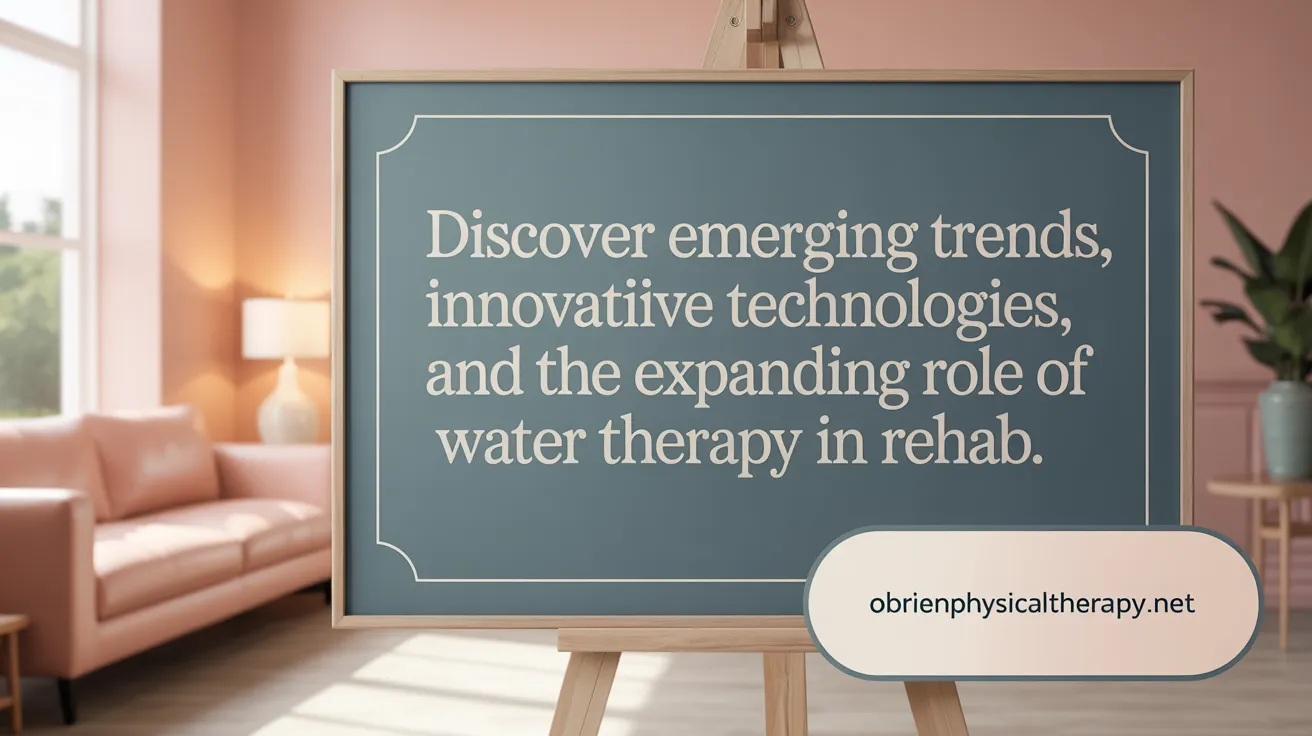
Emerging research trends
Ongoing studies continue to explore the diverse physiological and neurological benefits of water-based therapy. Current research is increasingly focusing on how aquatic therapy promotes neural plasticity, cognitive improvements during aging, and cardiovascular health enhancements. This growing evidence supports expanding applications of water therapy beyond traditional musculoskeletal and neurological rehabilitation.
Potential expansion into new patient populations
Water therapy's low-impact nature makes it ideal for elderly patients and those with chronic conditions such as Parkinson’s, multiple sclerosis, and fibromyalgia. Future rehabilitation protocols aim to include more diverse groups, including pediatric populations with neurological deficits and patients recovering from complex surgeries, to leverage the unique supportive environment water provides.
Integration with traditional rehabilitation methods
The combination of water and land-based therapies, exemplified by methods like the Burdenko Method, offers synergistic benefits by targeting balance, coordination, and strength through multiple modalities. Integrated protocols are expected to optimize clinical outcomes by incorporating controlled aquatic exercises alongside conventional physical therapy.
Technological advances in aquatic therapy
Advancements such as underwater treadmills, sensor-equipped pools, and tailored aquatic exercise programs are enhancing the precision and customization of water-based therapy. These technologies facilitate objective assessment, progressive training, and improved patient engagement, shaping the future of rehabilitation practices in aquatic settings.
Summarizing the Healing Potential of Water-Based Therapy
Water-based therapy stands as a multifaceted treatment approach blending centuries-old wisdom with modern scientific validation. Through its unique physical properties and physiological impacts, aquatic therapy presents an effective, low-impact way to alleviate pain, enhance mobility, and boost overall health across diverse patient populations. The combination of water and land-based exercises further amplifies these benefits, offering a holistic path to recovery and improved quality of life. As research and clinical applications continue to evolve, water-based therapy promises to remain an indispensable component in rehabilitative and therapeutic practices worldwide.
